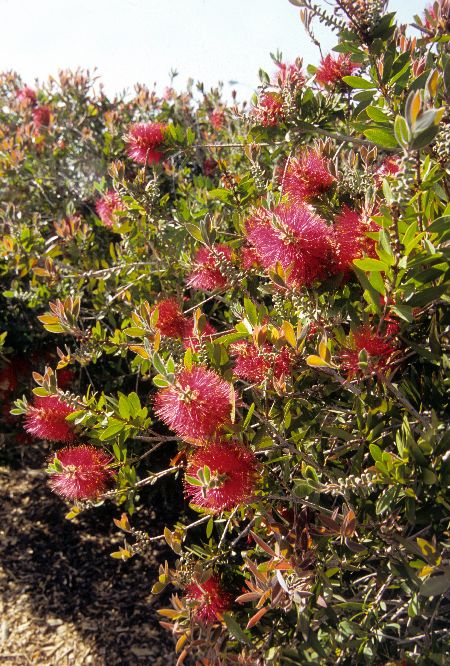
Callistemon citrinus
Lemon Bottlebrush
Lemon Bottlebrush is very accepting of pruning and shaping to become a shrub, screen or patio tree. New growth in spring has interesting coppery color. Rich red bottlebrush-shaped flowers are naturally striking. Canopy coverage: 177 square feet.
[Read More]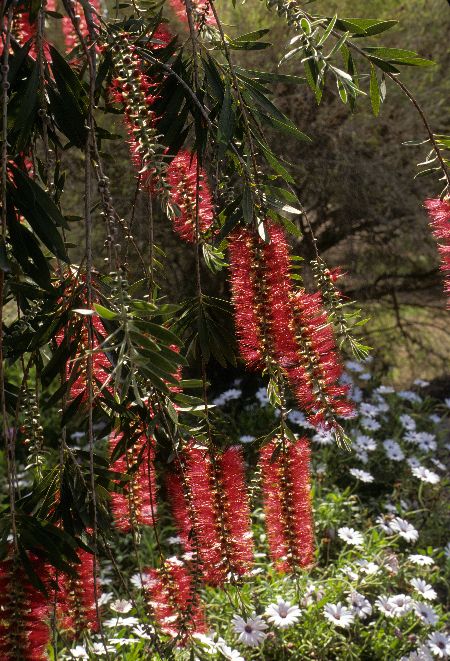
Callistemon viminalis
Weeping Bottlebrush
The branches of this small tree drape down in a pendulous fashion, showcasing the rich, red, bottle brush flowers. This Australian native does not like overly moist soil so avoid planting in lawns. Canopy coverage: 177 square feet.
[Read More]Catalpa speciosa
Western Catalpa
Western Catalpa produces an irregular crown, and is somewhat pyramidal in form. Leaves are large, coarse textured, shaped like hearts, and susceptible to damage in strong winds. Flowers are followed by long seedpods up to 18 inches long. Accepts sandy to loam soils, tolerates clay soils. Canopy coverage: 1,257 square feet.
[Read More]Celtis occidentalis
Western Hackberry
Adapted to grow in a wide range of climates, Western Hackberry is also known as Common Hackberry. Grows as a large shrub or tree—give it more water for tree form. Best to plant from containers rather than bare root for better establishment. Yellow fall color and small red to purple fruit are attractions. Canopy coverage: 1,963 square feet.
[Read More]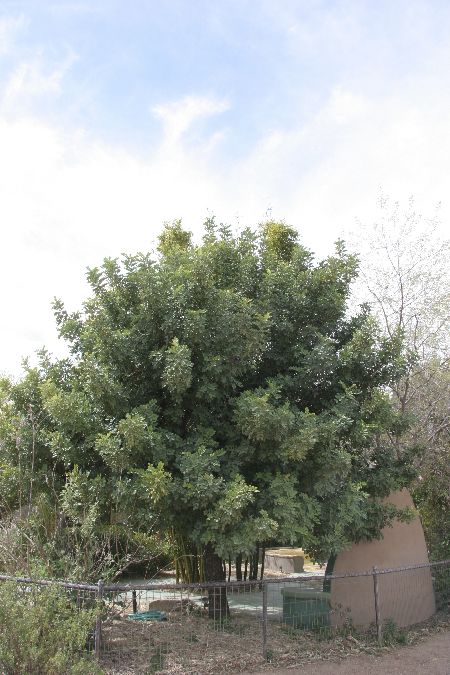
Ceratonia siliqua
Carob Tree
This evergreen tree has a round-headed form, its lush canopy producing dense shade. Flowers emerge as pinkish yellow, gradually turning red. Roots can be invasive. Female plants produce long brown seed pods that can be messy. Canopy coverage: 1,257 square feet.
[Read More]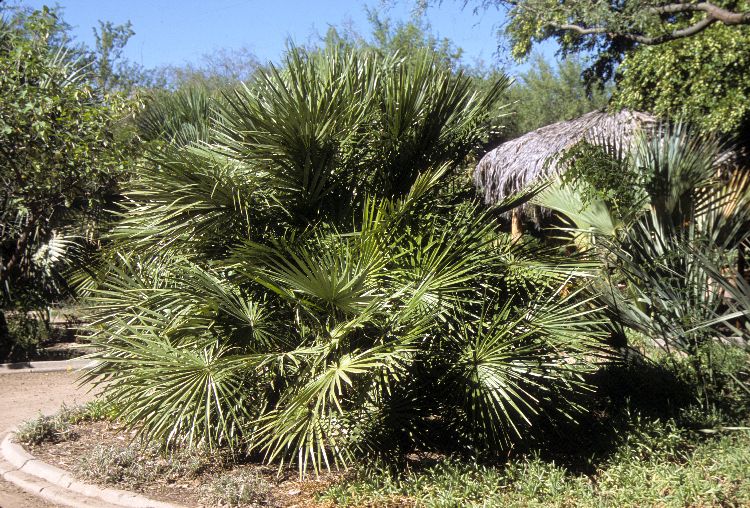
Chamaerops humilis
Mediterranean Fan Palm
This is a small, fan-type palm with a mature size (to 10 feet) to remain in scale for residential use. Best with some protection from the sun in hot summer regions. Canopy coverage: 50 square feet.
[Read More]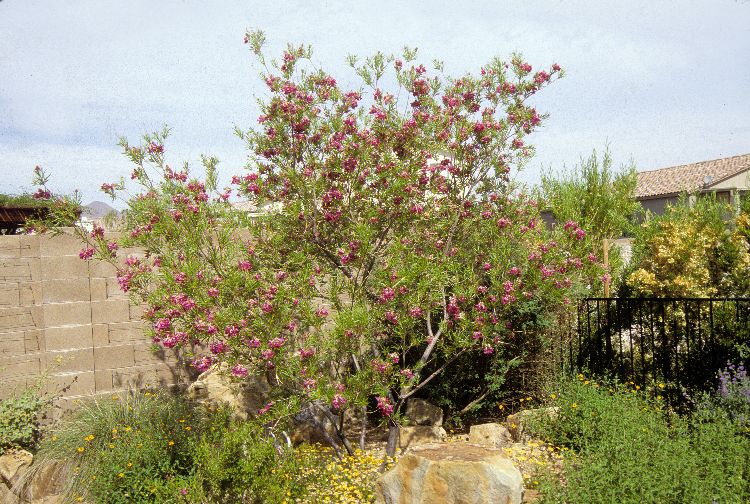
Chilopsis linearis
Desert Willow
Desert Willow is a bulletproof tree for hot-summer regions. Weeping form is appealing, as are the spring flowers. Long brown to tan seedpods add interest in winter. Many selections are available in a range of colors. Canopy coverage: 314 square feet.
[Read More]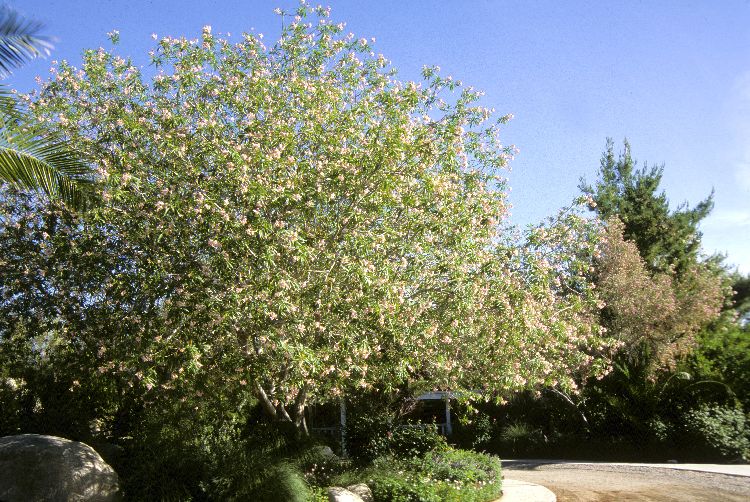
Chitalpa x tashkentensis
Chitalpa
Chitalpa is a hybrid of two genera: Chilopsis and Catalpa. It is a tough plant, accepting summer heat. Striking flowers and lush evergreen form are attractions. Many flower colors available. Look for the improved selection 'Morning Cloud'. Canopy coverage: 707 square feet.
[Read More]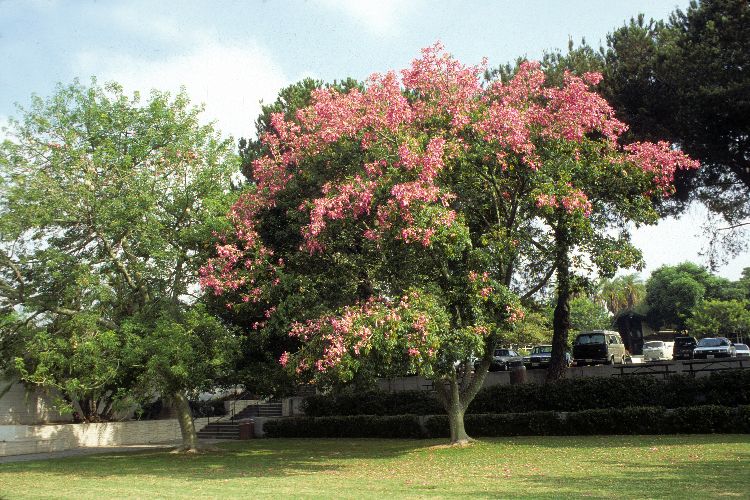
Chorisia speciosa
Silk Floss Tree, Kapok
Silk Floss Tree matures into a tall, wide-spreading tree with time, so select its location carefully. Winter cold can be an limiting issue, particularly with young trees. Puts on quite the color show in winter when other plants are quiet. Distinctive trunk is bright green and covered in thorns. Canopy coverage: 707 square feet.
[Read More]Citrus species
Citrus
Citrus comprise an extremely wide range of fruiting trees and shrubs. Each species has its own unique size, fruiting periods, cold hardiness and climate adaptations. There is not enough space here to provide complete information. Generally cold hardy from 25F to 32F, with limes being the most cold sensitive to frost. Oranges, mandarins and kumquats are among the most cold hardy. When irrigating Citrus, water away from the trunk and apply near the tree's dripline. See photo. Maintain regular irrigations for fruit production. Average canopy coverage: 177 square feet.
[Read More]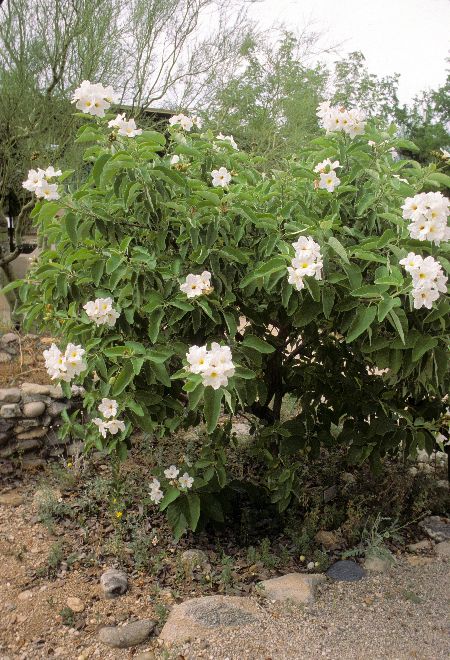
Cordia boissieri
Texas Olive
Large leaves and showy flowers provide a subtropical appearance. Semievergreen in cold climates. Canopy coverage: 79 square feet.
[Read More]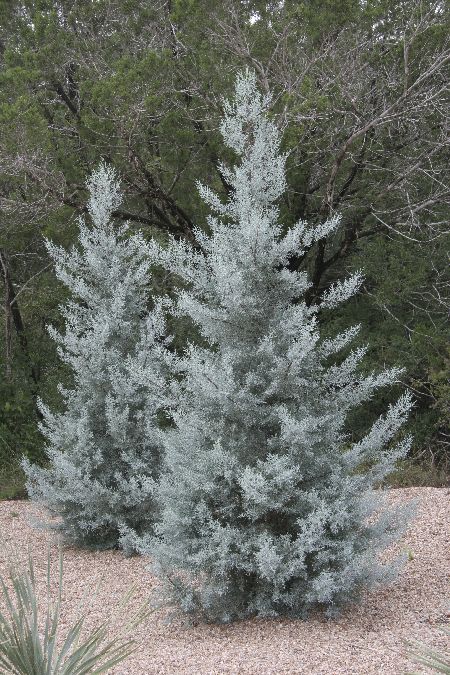
Cupressus arizonica
Arizona Cypress
Look for improved selections such as 'Gareei', 'Pyramidalis' and 'Blue Pyramid'. Cupressus glabra is similar, commonly known as smooth-barked Arizona cypress. Canopy coverage: 314 square feet.
[Read More]Cupressus arizonica var. glabra
Smooth Arizona Cypress
This Cypress is quite similar to Arizona Cypress. It is commonly known as Smooth Arizona Cypress. Bark is smooth and a cherry red color. 'Blue Ice' is a popular selection with silver-blue foliage. Canopy coverage: 314 square feet.
[Read More]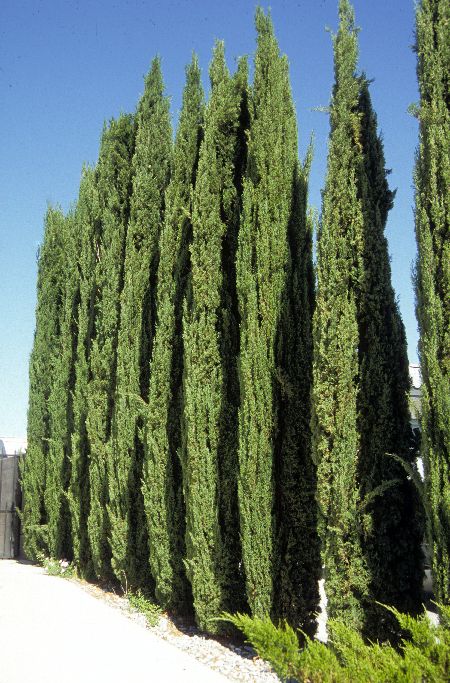
Cupressus sempervirens
Italian Cypress
Italian Cypress is well-known for its use in the formal landscape. Selections 'Stricta' and 'Glauca' (blue-green foliage) present more refined forms. Canopy coverage: 50 square feet.
[Read More]Dalbergia sissoo
Indian Rosewood
Indian Rosewood is valued as a shade tree in regions where it is adapted to winter cold temperatures. An evergreen, but cold can cause it to drop leaves in winter. Canopy coverage: 707 square feet.
[Read More]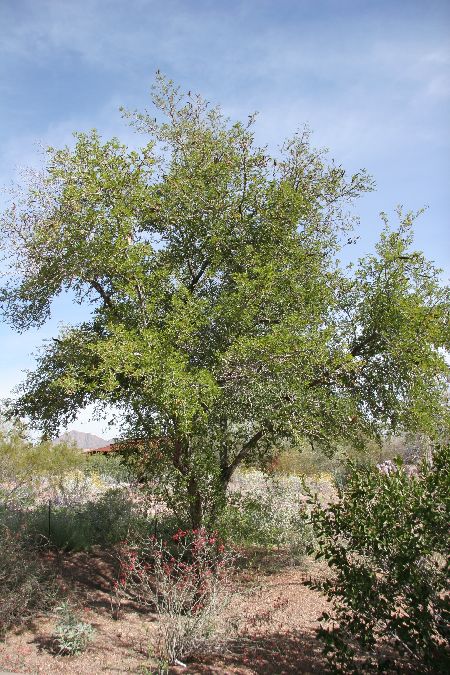
Ebenopsis ebano
Texas Ebony
Texas Ebony makes an attractive small tree. Bark can sunburn in hot-summer areas, so prune carefully to avoid too much sun exposure, especially when plants are young. Canopy coverage: 314 square feet.
[Read More]Eriobotyra japonica
Loquat
Large leaves and edible pear-shaped fruit give this tree a subtropical feeling. Be aware fruit are damaged at 28F. Best with some protection from the sun in hot summer regions. Look for 'Champagne' or 'Thales' for more tasty fruit. Canopy coverage: 177 square feet.
[Read More]
Eucalyptus cinerea
Argyle Apple, Silver Dollar Gum
Interesting reddish bark on twisting branches and stark, grayish leaves are attractions of this Eucalyptus. Leaves are round in juvenile (young) stage, then elongate and curve as they age. Foliage is so distinctive it is often used in floral arrangements. Canopy coverage: 491 square feet.
[Read More]Eucalyptus leucoxylon
White Ironbark
Mature size of this tree is highly variable depending on soil and moisture conditions. Consider height and width noted here as a general guide. Also consider Eucalyptus leucoxylon rosea, and its hot pink flower show in winter. Canopy coverage: 707 square feet.
[Read More]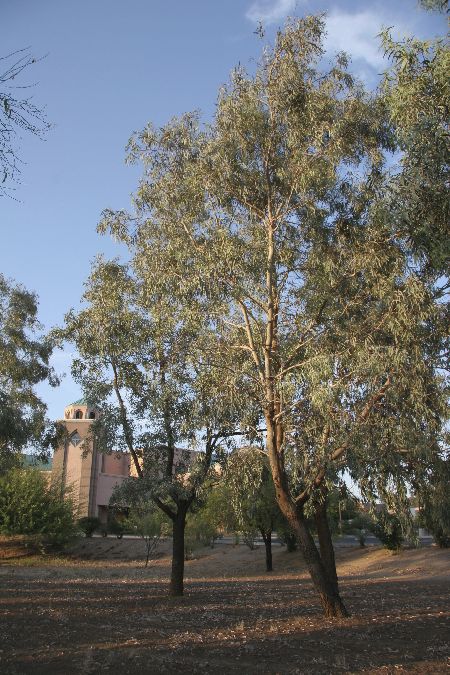
Eucalyptus microtheca
Coolibah
This is a Eucalyptus that typically remains in scale for residential use. Can make a nice, tall screen. Canopy coverage: 491 square feet.
[Read More]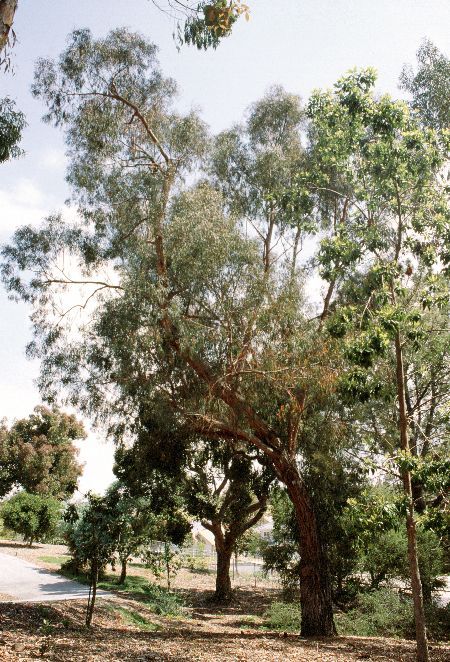
Eucalyptus nicholii
Narrow-leaved Black Peppermint
Fast growth and potential long life make this Eucalyptus a good garden selection. Nice, attractive weeping form. Leaves emit a peppermint scent when crushed. Deeply fissured brown bark adds interest. Canopy coverage: 1,257 square feet.
[Read More]